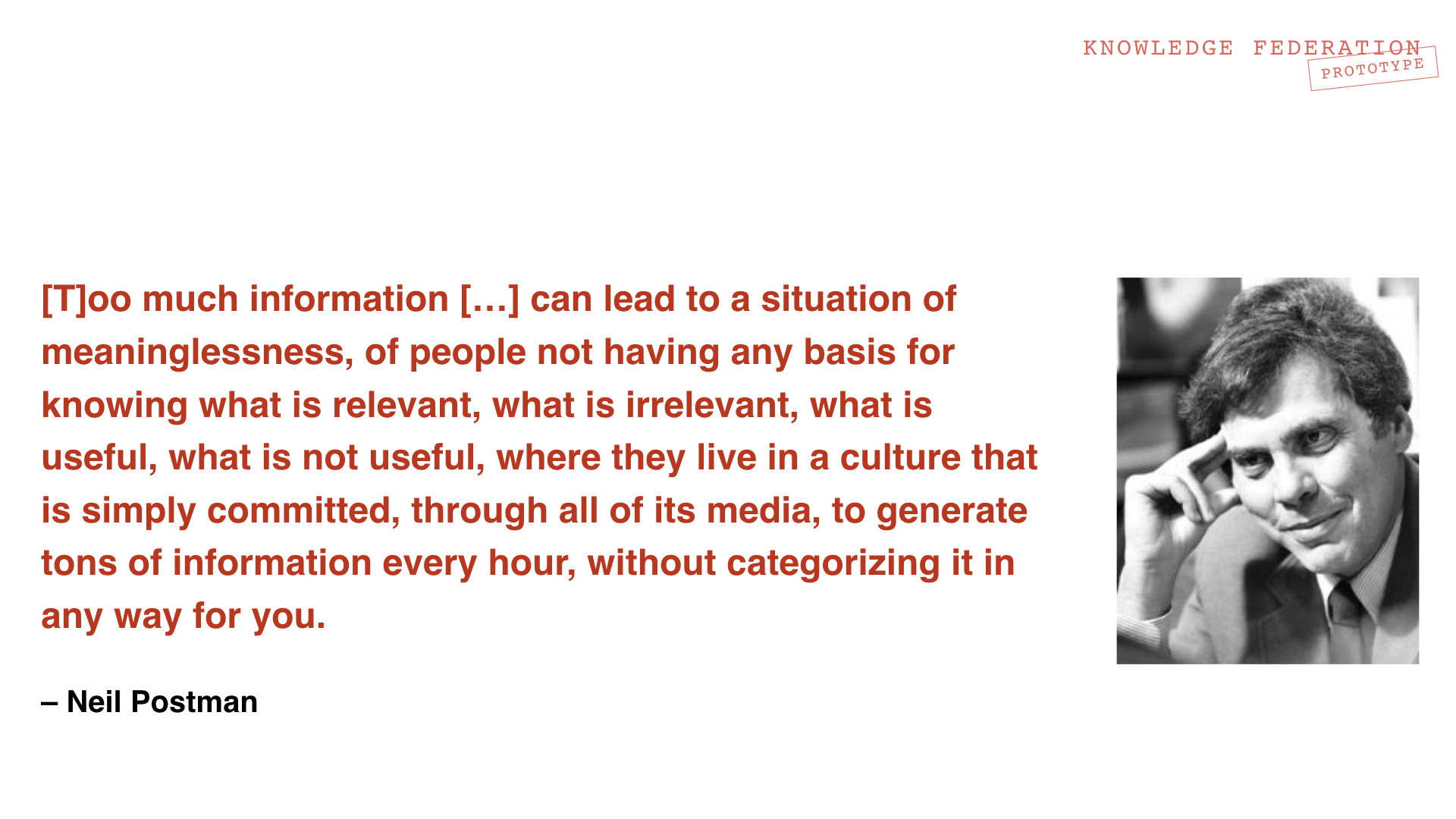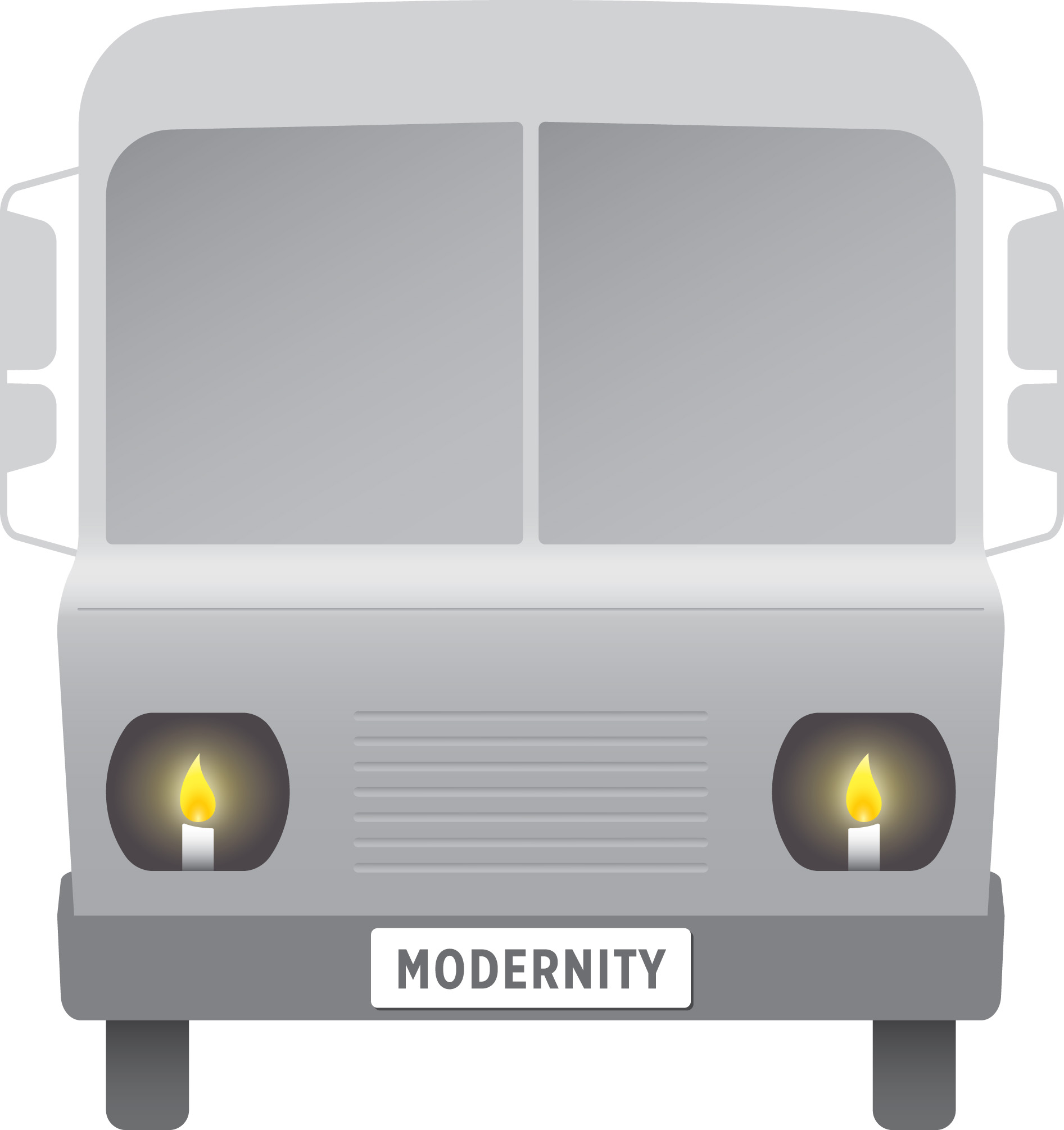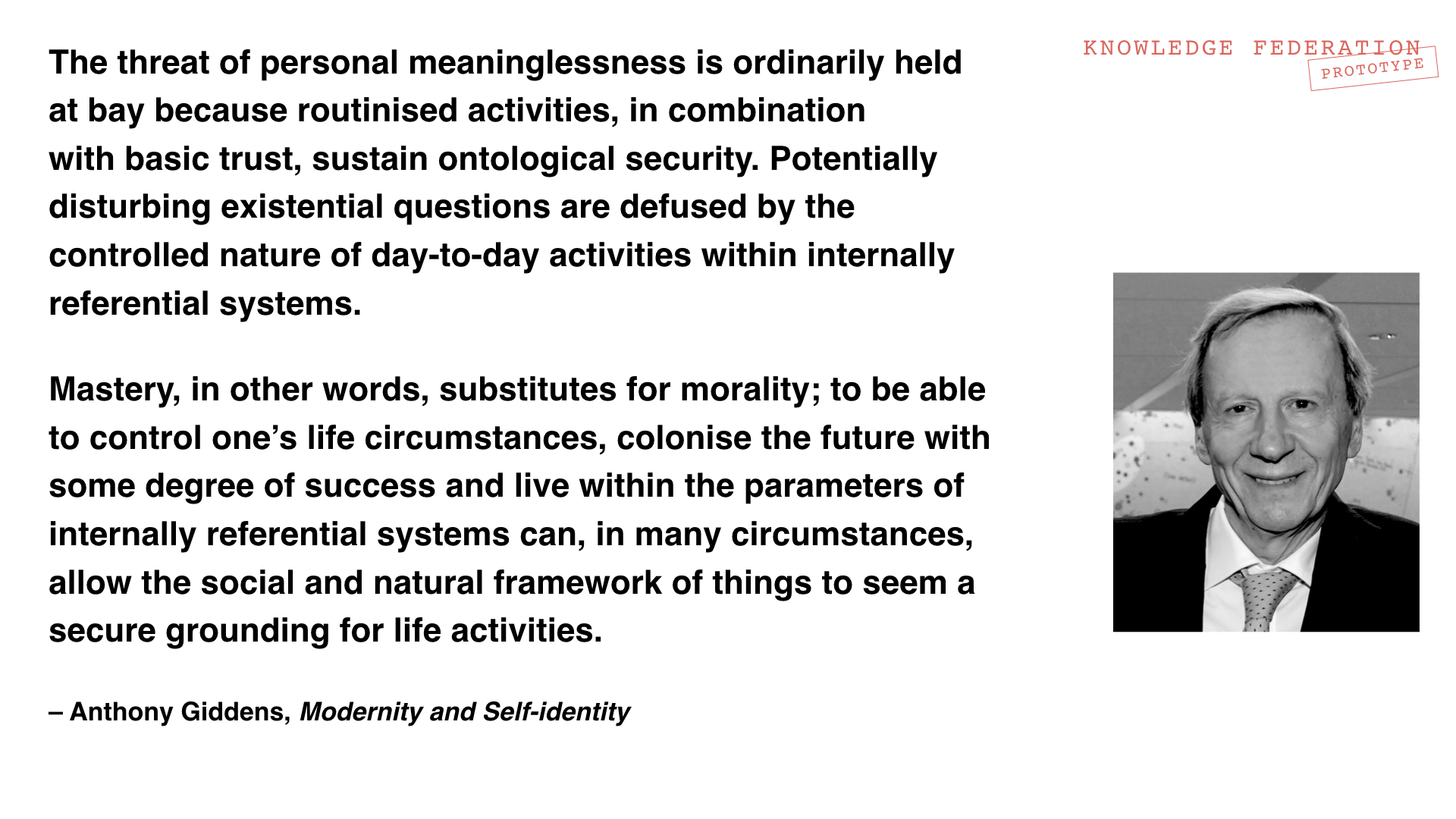Holotopia
Contents
Holotopia
We have lost the sense of direction
In 1990, when Tim Berners Lee was still writing the code for the World Wide Web, Neil Postman (NYU's distinguished scholar of culture and communication) warned us that our habitual massive outpouring of information tends to have the opposite effect from the one intended. It not only leaves us uninformed—but it damages our very sense of meaning; our very capacity to be informed!
Imagine a world where information and the way it is handled are consciously adapted to their core purpose—the creation of meaning. Where information is treated as a human-made thing; and adapted to the core functions it needs to fulfill in various other things. Such as our lives, and our society.
What would the resulting information be like? By what methods, in what ways and by whom would it be created? How would information be used? What new information formats, what new kinds of information would emerge? How would the information technology be adapted and applied? In what way would our public informing be different? What would academic communication, and education, be like? By creating the Knowledge Federation prototype, we provided an academically coherent answer to those and other related questions; answers that are not only described and explained, but also implemented, as real-life embedded prototypes.
But having done that, we are still facing the same challenge that our visionary predecessors failed to overcome.
We seem unable to make a change
Our next and most intriguing challenge is not a problem that can be solved, but a paradox.
Having been socialized to "mind our own business" and just publish more, as scientists or as journalists (because that's what we are paid to do, and what our careers depend on and our institutions require)—we have no incentive, no institutionalized methods, no will and no willpower to make the kind of changes that would put information and knowledge into the service of meaning—the kind of meaning that our condition and the condition of our society demand.
A goal of the Holotopia prototype, which is currently in development, is to overcome that obstacle.
What would our world be like, if we elevated the most vital insights from the "information jungle", and wove them together to give us the required or functional vision? How would our world be different, if the best ideas of our best minds were reflected in our comprehension of things—and acted on?
The purpose of Holotopia is to not only provide answers—but to also empower us to implement the changes they are pointing to.
What would it take to change course?
Based on a decade of The Club of Rome's research into the future prospects of mankind, Aurelio Peccei diagnosed that the humanity is on a collision course with nature. We take his diagnoses as a challenge, and as a natural benchmark test for our project. Can the new 'headlights' we are proposing help us "change course"? And if they can—what would the new course be?
A vision
As a vision of a possible future, the holotopia is a positive answer to the question posited in this website's preamble:
Think about the world at the twilight of the Middle Ages and the dawn of the Renaissance: devastating religious wars, terrifying epidemics… Think of the scholastics pondering about the angels dancing on a needlepoint; and Galilei in house arrest, whispering “and yet it moves” into his beard. Observe that the problems of the epoch were not resolved by focusing on those problems, but by a slow and steady development of an entirely new approach to knowledge. Several centuries of comprehensive evolution followed. Could a similar advent be in store for us today?
Just as the case was in Galilei's time, a new order of things or paradigm is ready to emerge—as soon as we once again begin to use the knowledge of knowledge, to update the very way in which our knowledge is being handled. As Galilei and other founding fathers of science did.
The holotopia is a more desirable future than the common utopias—whose authors lacked the information to see what is possible. Yet the holotopia vision is fully realizable—we already own the information that is needed for its fulfillment.
Five insights
The holotopia vision is made concrete or federated in terms of the five insights:
- The Convenience Paradox insight points to a revolution in "the pursuit of happiness" and in culture, reminiscent of the Renaissance
- The Power Structure insight points to a revolution in innovation by which human work is made incomparably more effective and efficient, as the Industrial Revolution did
- The Collective Mind insight points to a revolution in communication, analogous to the advent of the printing press
- The Socialized Reality insight points to a new way to create truth and the meaning, analogous to the Enlightenment
- The Narrow Frame insight is about a new way to create knowledge that is capable of providing high-level insights— analogous to science, and complementing science
While the upper three insights point to developments corresponding to the Renaissance, the Industrial Revolution and the revolution in communication that the printing press made possible, the bottom two insights explain why an Enlightenment-like change is ready to happen for fundamental reasons, as a consequence of the knowledge of knowledge we own. Hence together, the five insights complete a vision of a complete order of things, which is ready to emerge.
A strategy
While each of the five insights will alone show us our time and condition in a similar light as we might see the circumstances from which the Enlightenment emerged, even more illuminating are their relationships. By exploring those relationships, we realize that we cannot meaningfully respond to any of those insights, without responding to them all.
A larger, overarching insight results:
Comprehensive change might be easy, even when smaller and obviously necessary changes may seem impossible.
This insight points to the strategy that gave the holotopia its name—where instead of focusing on specific problems, or specific improvements, we consciously aim to understand and transform the very order of things that holds them in place.
Making things whole
Considered together, the five insights point to a simple principle or rule of thumb: Instead of seeing the world in the light of our narrowly conceived self-interest (and trusting that "the free competition" or "the invisible hand" of the market will turn our self-serving acts into the greatest common good, which is, in the light of the five insights, perceived as markedly "Middle Ages")—we see ourselves and what we do as parts in a larger whole or wholes. And where we act in ways that make those larger wholes more whole.
Hence this formula (which Vibeke didn't like, but since nobody's reading this yet, let's leave it for now as Dino's private joke and foible):
But seek ye first the systemic wholeness, in all matters and on all levels of detail; and all these things shall be added unto you.
Seeing things whole
In the context of the Holotopia prototype we condense and simplify the core ideas of our knowledge federation proposal, until only its essence, which is its function, remains and meets the eye. To that end, we use knowledge federation only as a verb; and we refer to the proposed approach to knowledge by its pseudonym holoscope—which points to its core function, to help us see things whole.
 Every whole has sides that are obvious, and sides that are hidden. A purpose of the holoscope is to illuminate what has remained obscure, so that we may correctly see our object of interest's shape and proportions.
Every whole has sides that are obvious, and sides that are hidden. A purpose of the holoscope is to illuminate what has remained obscure, so that we may correctly see our object of interest's shape and proportions.
If we should make things whole, we must first see them whole. And that's, of course, where the holoscope comes in.
The social role of the holoscope is to complement the traditional approach in the sciences:
Science gave us new ways to look at the world, and our vision expanded beyond bounds. The telescope and the microscope enabled us to see the things that were too distant or too small to be seen by the naked eye. At the same time, science had the tendency to keep us focused on things that were either too distant or too small to be relevant – compared to all those big things nearby, which now demand our attention. The holoscope is conceived as way to look at the world that helps us see any chosen thing or theme as a whole – from all sides; and in correct proportions.
An intervention
Margaret Mead appears here in the role of the Holotopia's icon. Her familiar dictum points to the holotopia's core mission:
It is, however, the 'small print' that we found most relevant—her explanation of what exactly makes "a small groups of thoughtful, committed citizens" capable of making a difference."Never doubt that a small group of thoughtful, committed citizens can change the world; indeed, it's the only thing that ever has."
This Mead's observation, made a half-century ago, points to a key function of holotopia:
One necessary condition of successfully continuing our existence is the creation of an atmosphere of hope that the huge problems now confronting us can, in fact, be solved—and can be solved in time.
A space
Holotopia undertakes to develop whatever is needed for "changing course". Imagine it as a space, akin to a new continent or a "new world" that's just been uncovered—which combines physical and virtual spaces, suitably interconnected.
In a symbolic sense, we are developing
- A fireplace
- A library
- A workshop
- A gallery
- A stage
The Box
Holotopia's Box is an object designed for 'initiation' to holotopia, a way to help us 'unbox' our conception of the world and see, think and behave differently; change course inwardly, by embracing a new value.
We approach The Box from a specific interest, an issue we may care about—such as communication, or IT innovation, or the pursuit of happiness and the ways to improve the human experience, and the human condition. But when we follow our interest a bit deeper, by (physically) opening the box or (symbolically) considering the relevant insights that have been made—we find out that is a large obstacle, preventing our issue to be resolved. And that by resolving this whole new issue—a much larger gains can be reached than what we originally anticipated and intended.
Furthermore we see that there are still other such insights; and that they are all interdependent and related.
A vocabulary
Every new paradigm brings with it a new way of speaking. This collection of keywords is an alternative natural entry point to holotopia.
- Academia
We define academia as "institutionalized academic tradition". The point here is to be able to inquire whether the contemporary academia is still legitimately performing that role.
- Epistemology
The epistemology, identified as the knowledge of knowledge and its various consequences, is the keyword we use to point to the very core function of the academic tradition. What Socrates, and Galilei, and so many other great innovators of knowledge work had in common, is that they used knowledge of knowledge to counter the effects of socialization. And in that way help knowledge, and humanity, come out of its evolutionary pitfalls, and evolve further.
- Mirror
The mirror is a gestalt, which points to the nature of the condition the contemporary academia is in. We keep busy with business as usual; but our condition demands that we stop and self-reflect. And when we do that, in the light of the available insights, we see that a major change of epistemology is called for, leading to a change our self-perception and self-identity. We are not 'above the world', observing it "objectively"; we are in the world; and we are responsible for it. For a moment, our evolution may seem to have reached a dead end; but this end is truly a new beginning. The holoscope, and the holotopia, model the academic and the social realities on the other side of the mirror.
- Truth by convention
What is "truth" if it's not "correspondence with reality"? The holoscope consistently uses truth by convention—which is the kind of truth used in mathematics: "When I say X, I man Y. There is no point asking whether X "really is" Y...
- Keyword
The keywords are defined by convention—hence they are allowed to have different meanings than they do in our traditional paradigm. They allow us to speak, and also think differently.
- Paradigm
The paradigm is an "order of things"—a collection of things that are so related to each other, that changing one of them requires that we change them all.
- Elephant
The elephant is nearly synonymous to the paradigm. We use this keyword to point to the fact that an emerging paradigm is like the proverbial "elephant in the room". That the visionary thinkers who anticipate it, like the proverbial "blindfolded men touching the elephant", see and described its different parts, in ways that may at first seem unrelated and meaningless. And that our core aim is to use their insights as roadsigns, which help us see the whole big thing.
- Wholeness
Wholeness is what distinguishes a healthy organism, and a whole and well-functioning mechanism. The point here is to see that it's not any detail as such, but the wholeness they compose together, that makes "a difference that makes a difference". Wholeness is the value that defines the holotopia.
- Culture
Culture is defined as cultivation of wholeness; cultivation is defined by analogy with planting and watering a seed.
- Information
Just as we do in cultivation of land, we depend on the experience of others to do any sort of cultivation. We define information as "recorded experience".
- Gestalt
A gestalt is a way in which any situation or theme is comprehended, which points to a way in which it may need to be handled. The point here is that multiple gestalts tend to be possible. And that having a gestalt that is appropriate to our situation is tantamount to being "informed".
- Dialog
It is a natural tendency of our mind to hold on to a certain gestalt, and reject others. The dialog is a culture of communication where we consciously resist and counteract this tendency. David Bohm rightly considered the dialog as a prerequisite to true communication; to changing the paradigm; and to resolving our core issues by evolving further.
- Socialization
Sergei Chakhotin was first a researcher in Ivan Pavlov's laboratory; and then participated in the 1932 German electoral campaign against Hitler. We mention him here because of the observation he made: Hitler was doing to the German people what Pavlov was doing to his dogs; he was socializing them. We use this keyword to point to all various ways in which people's gestalts, worldviews, values... can be subtly or overtly manipulated, even without anyone noticing.
When we've been socialized to accept a certain worldview as "reality", we tend to respond to anything that disrupts it with antagonism, or even anger. The dialog requires that we be mindful of such tendencies, and consciously counteract them.
Thus the holotopia may be understood as an intervention into our contemporary condition, which empowers us to counteract our socialization, acquire new gestalts, and ultimately change the obsolete paradigm we are in, and evolve further. Just as our distant ancestors did in Galilei's time.
And at so many other times in the past.







